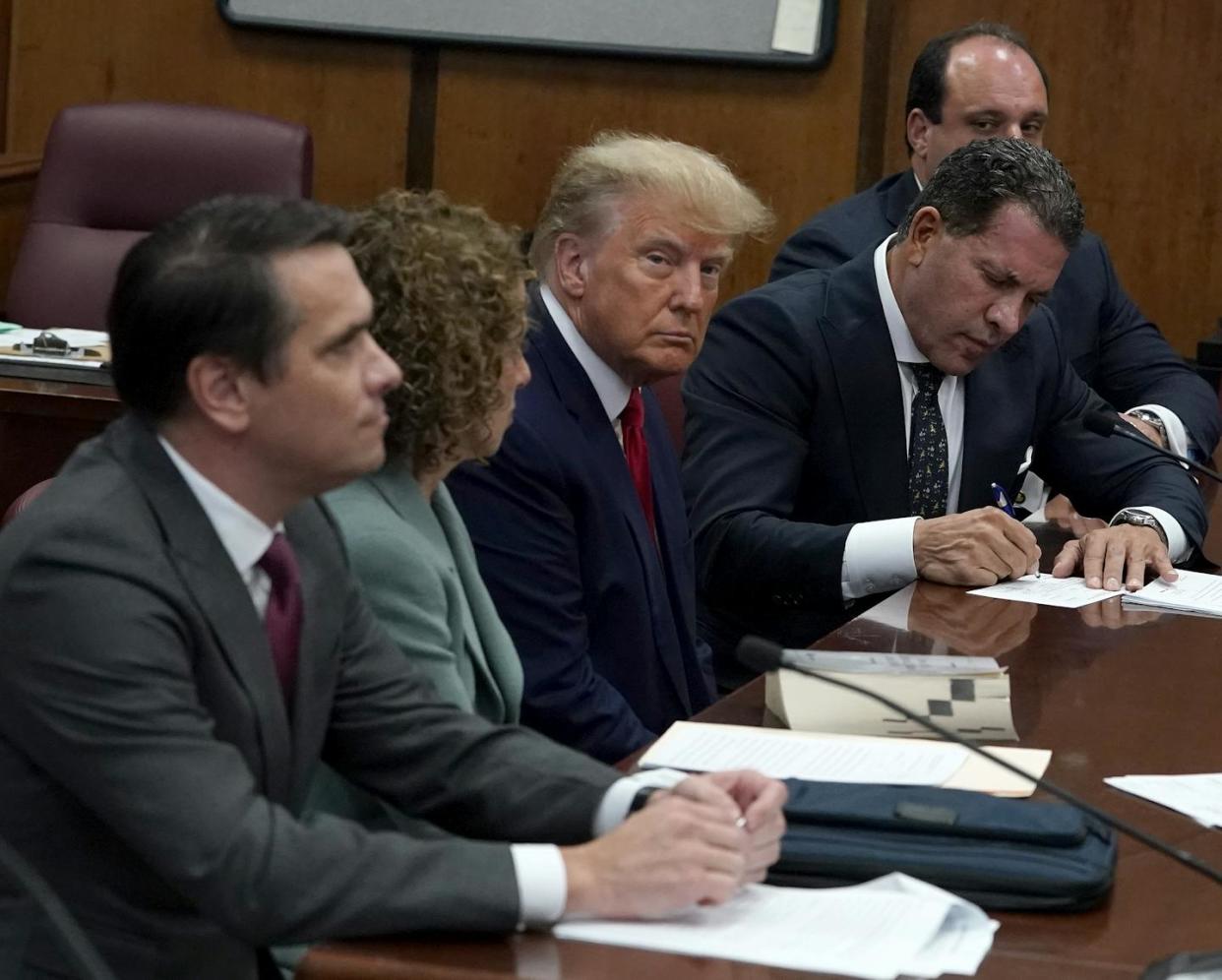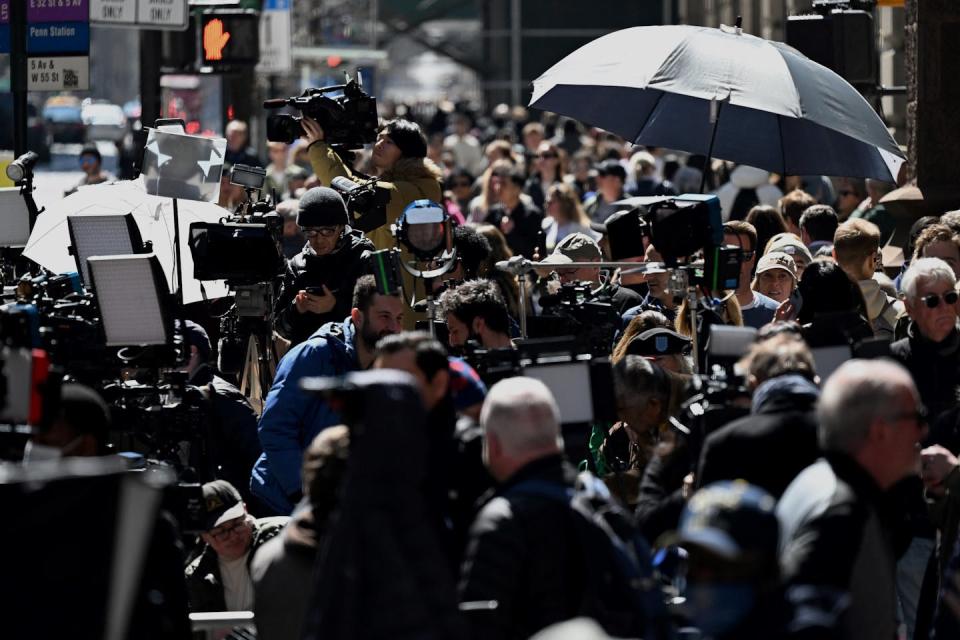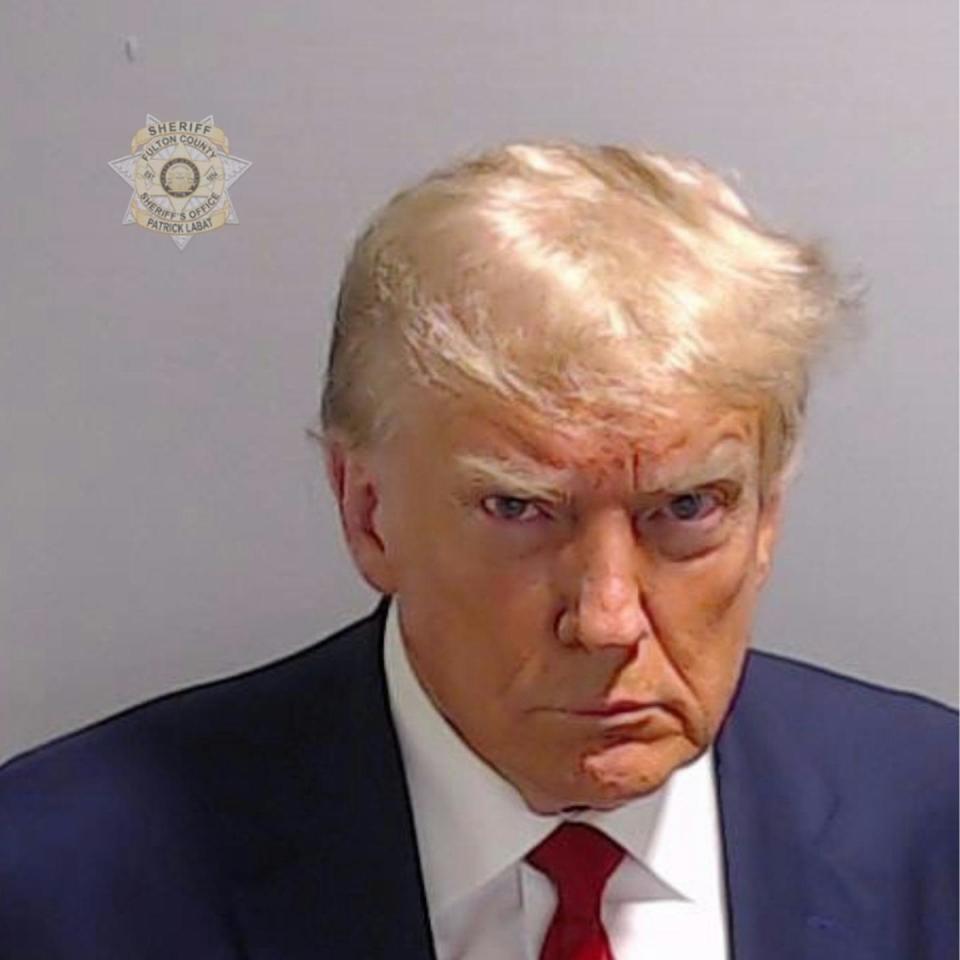Trump’s New York felony charges are going to trial – what the images might show when the business fraud case kicks off

- Oops!Something went wrong.Please try again later.
When former President Donald Trump soon returns to court in New York City, there are likely to be few visual surprises. Trump’s hush-money trial before New York Judge Juan Merchan is scheduled to start with jury selection on April 15, 2024.
Monday’s scene will likely echo the one from 2023, when Trump walked past cameras into a courthouse in order to appear for his arrest on 34 felony charges for allegedly committing business fraud and paying porn star Stormy Daniels money to remain quiet about her claims of their sexual encounter. As historic as the moment was, the visuals were rather bland.
Still photos from inside the courtroom will capture the scene silently, so even if the former president speaks out of turn, as he occasionally does in court, outside viewers will not hear the audio. New York courts allow cameras into criminal proceedings, but journalists must get permission to be there, and judges will impose different rules on a case-by-case basis.
Dozens of news photographers will be posted inside and outside the courthouse, working within strict guidelines about where they can stand and when. Yet the courtroom scene is not likely to be the sort of media free-for-all shown in movies and TV shows. Judges and news organizations may work for weeks or months to ensure that court operations run smoothly during spectacular cases.
I have studied the way visual journalists cover criminal justice for 20 years. All this preplanning tends to yield pretty matter-of-fact imagery, but three things will be worth looking for in the visual coverage of Trump’s appearance: surprises, body language and symbolic juxtapositions.

The unexpected
Surprises will be hard to come by. True, the former president likes to play to the cameras when he can, but he faces legal challenges on multiple fronts, and so far, he has been compelled to maintain a civil demeanor when being photographed in court.
Even in the most camera-friendly jurisdictions, such as New York and Florida, photojournalists are subject to strict rules about placement and procedure. My research for my 2021 book, “Seeing Justice,” found that media and the court system often work together to balance the public’s interest in a case with a need to maintain order.
In fact, arrangements for major cases can mimic the plans for major league sporting events. During the 2013 George Zimmerman trial for the murder of Black teenager Trayvon Martin in central Florida, for example, court representatives met with local TV engineers to determine where news vans could park. Cameras were set up inside the courtroom, and an overflow room was arranged so the journalists who didn’t have access to the courtroom could still watch the proceedings.
Body language
During Trump’s upcoming trial, viewers will be watching for cues from his body language, particularly his facial expressions. Often visual coverage for a criminal court case lets the audience know what the accused looks like, but most viewers are well-acquainted with the former president’s appearance. Instead, people will be watching for clues about his mood.
Will the former president look angry, as he has during previous court appearances? Will he look solemn? Nervous?
Visual coverage can often expose so much more than words about a person’s mood. Human beings instinctively read faces as part of social interaction. Infants track faces before other visual information.
Some experts estimate that a majority of the information people take in from a conversation can be nonverbal, though exactly how much they rely on this kind of information is subject to debate. What is clearly established in the research is that, whether in-person or through media, we are drawn to faces. We notice them, read them and respond emotionally to them. Mirror neurons, a type of brain cell, are activated when we read the faces of others, prompting our own emotions to flicker in reaction to others’ apparent feelings..
Coverage from Trump’s appearance before Merchan on April 4, 2023, for instance, included observations about his body language, how he walked into the building, how he quietly interacted with his lawyers, and so on. He waited to be among supporters in Florida that day before more forcefully expressing his anger and frustration.

Visual irony
Finally, those of us who are deeply interested in visual communication will be watching for symbolic juxtapositions. A still photo from the pool camera in April 2023, for example, included a bulletin board in the background in which a small American flag had been inserted.
Who put it there, and why? This tiny American flag, displayed next to what looks like a photocopied map of the state of New York and other nondescript notices, added a touch of the mundane to the historic moment.
The courtroom where Trump sat was just one of many of its kind across the country. The plain bulletin board with its little flag robbed the scene of grandiosity normally associated with the presidency.
The photojournalists stationed in and outside of the courthouse will be very busy and likely tense as they prepare to capture photos and video of the former president. But this chaotic scene will be largely hidden from the audience.
Photojournalists will likely work from cordoned-off pens in the Manhattan Criminal Courthouse, and if their scrums are anything like the others I’ve studied over time, they’ll gather very early, stake claim to key spots and spend far more time waiting than recording video.
Visual journalists from competing organizations will greet one another as professionals do at a convention, with handshakes and catch-up conversations. After all, many of these photojournalists will spend more time in these groupings than they will with members of their own news organizations. The friendly mood will stop cold, though, once the action starts.
Even though everyone knows what Trump looks like, and even though his walk through the hallway may take only a matter of seconds, it will be essential to capture that moment, for their own job, their professional reputation and, of course, to satisfy the public’s curiosity.
This article is republished from The Conversation, a nonprofit, independent news organization bringing you facts and trustworthy analysis to help you make sense of our complex world. It was written by: Mary Angela Bock, The University of Texas at Austin
Read more:
Mary Angela Bock has received funding from the Association for Education for Journalism and Mass Communication. Since October 2023, Bock has contributed $150 to ActBlue, a political action committee that fundraises for Democratic nonprofits and politicians.

